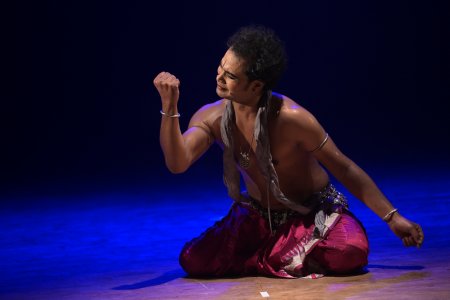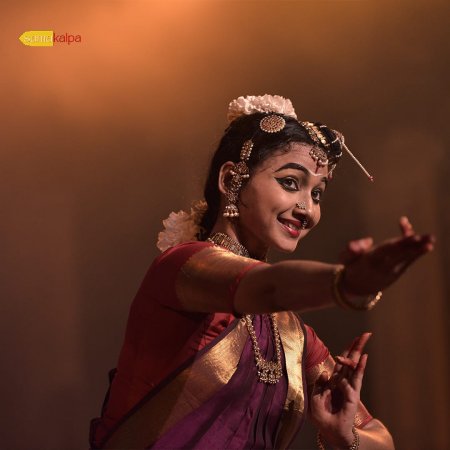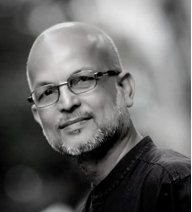
|   |

|   |
Samakalpa - a timely venture - Shyamhari Chakra e-mail: shyamharichakra@gmail.com Photos: Manas Babu May 19, 2025 Both of them are techies by profession and Odissi dancers by passion. They hail from Odisha and are based in Hyderabad. Both of them have also a common concern - how to turn the "pay and perform" syndrome that is plaguing the Indian classical dance scene into a dignified "perform-and-be-paid" provision. However, they didn't know each other until last year when they worked together to mount Hyderabad Odissi Utsav. And thus, was born Samakalpa (envisioning alike), an aptly titled and timely venture conceptualised by these two young dancers - Arpita Pani and Sonali Mohanty. "We used to look out for opportunities to perform as soloists. But we were disappointed to discover that there was hardly any such scope. It further pained us a lot to learn that young dancers like us are asked to perform free-of-cost or to pay the organisers to perform. So, we wished to challenge and change the wrong trend that doesn't respect dancers' labour of love. Like in any other profession, dancers deserve to be paid too. We decided to host a series of ticketed dance concerts across cities in order to pay the performers and sensitise the audience and the festival organisers as well," they shared. "To start with, our focus has been on promotion of promising young dancers and choreographers of various Indian classical dance traditions who deserve timely recognition", the hosts mentioned. The inaugural event of the Samakalpa series titled "Pravritti - An Ode to Tradition" was staged in Odisha's capital city of Bhubaneswar recently at the Guru Kelucharan Mohapatra Odissi Research Centre auditorium that provides an apt aesthetic ambience for mounting classical dance concerts in an intimate space that is frequented by the dancers and dance connoisseurs of the city. The hosts who were the curators as well, invited two gifted young soloists of their generation - Bharatanatyam dancer Harinie Jeevitha from Chennai and Odissi dancer Rudraprasad Swain from Bhubaneswar for the inaugural episode. And as selfless promoters, both the hosts abstained from being performers in the event. Groomed by her guru Sheela Unnikrishnan at Sridevi Nrithyalaya in Chennai, Harinie has emerged as one of the most visible and promising artistes of her generation. A Bachelor's degree holder in English literature and a Masters in Bharatanatyam, she had her arangetram (debut performance) in 2006 following which she has been performing frequently as a soloist and reaping rave reviews. Taking up dance as her profession, she has been a faculty member at her alma mater Sridevi Nrithyalaya founded by her guru and has shown signs of a promising choreographer at a relatively young age. Dance apart, Harinie has also penned and published two anthologies of her poems that speaks volumes of her pursuit for creativity. Unlike Harinie, Rudraprasad had to encounter several disadvantages to establish himself as a professional dancer. Hailing from a family of farmers of Dimirisena village near Puri in Odisha - known as the birthplace of the Gotipua dance tradition - he was offered to the local Shiv temple to serve as a Gotipua dancer at the tender age of five. Growing up, he was groomed as an Odissi dancer at legendary Odissi Guru Gangadhar Pradhan's famed Odisha Dance Academy in Bhubaneswar where eminent exponent Aruna Mohanty was his mentor who sent him to USA in 2010 to serve as a guest faculty at an Odissi dance institute. In his venture to be a solo dancer and choreographer, this young dancer left the secured job as a faculty member at Odisha Dance Academy and set up his own Odissi dance institute - The Sanchari Ensemble - in Bhubaneswar that has shown signs of professional progress. He has performed his own choreographies at prestigious festivals like the Kala Ghoda Arts Festival, Raindrops Festival, Nishagandhi Dance Festival, Uday Shankar Dance Festival and at Nita Mukesh Ambani Cultural Centre.  Rudraprasad Swain Rudraprasad, who opened the festival, presented two of his recent choreographies - Varsha Viraha followed by Abhimanyu. Visualized on a poem penned by prominent modern Odia poet Mayadhar Mansingh, Varsha Viraha delineated the agony of a lover who is terribly missing his beloved while the monsoon fills in him an intense romanticism. The feelings of his heart remain unuttered that sinks him into sorrows with the endless wait as he looks at the sky with a blank look. Rudraprasad has choreographed the production with guidance of his current mentor, eminent Bharatanatyam artiste Rama Vaidyanathan. Abhimanyu, his second presentation, revolved round the familiar tale of Abhimanyu from the epic Mahabharata, how the brilliant young warrior - son of Arjuna and Subhadra - could invade the formidable battle formation known as Chakravyuha designed by the seven mighty warriors but was killed mercilessly and unethically as he only knew the secrecy of the entry and not of the exit that his father alone knew. Though the spectators were quite familiar with the story, what appealed to them was its refreshing treatment by the choreographer-dancer. Supplemented by superb light-design by Debiprasad Mishra, the production starts with an introduction of the protagonist as a valiant warrior through an excellent exploration of the body kinetic and then the narrative travels back in time in a flashback when Arjun explains to Subhadra the way to enter the Chakravyuha and the yet-to-be-born baby Abhimanyu listens it while being in the womb. However, the baby fails to know the way to exit from the complex battle formation as the mother falls asleep. The accompanying music pauses for a moment to suggest Subhadra falling asleep - this suggestive sequence showed the creative brilliance of Rudraprasad as choreographer.  Harinie Jeevitha Harinie's Bharatanatyam concert that stole hearts - Varadarajam Upasmahe - was her first solo thematic production that spoke volumes of this talented young dancer's future as a promising choreographer. Its narrative was woven around the festivities, rituals and stories associated with the grand celebration of Brahmotsavam, a 10-day annual temple festival of Varadaraja Swamy temple in Kancheepuram, Tamil Nadu. Stringing together excerpts and references from the literary and musical compositions of saint-poets in Sanskrit, Tamil and Telugu, Varadarajam Upasmahe delineated the unique proceedings of the festival. In her intelligent approach for a proper understanding of the concert by the spectators, Harinie screened video footages of the festival prior to commencement of her concert. Thus, the audience, who were not familiar with the festival, could relate to her story-telling through the language of dance that followed the screening. As the recital started, the dancer appeared on stage as an ardent devotee who has travelled all the way to the temple town to witness the spectacular celebrations. And through the eyes of the devotee, the audience could watch the gradual unfolding of the celestial events. Harinie literally transported them to the streets of Kanchipuram where they became a part of the procession and the proceedings of the celebrations. The soul-stirring chanting of the Vedas that was added to the background orchestra magnified the mood of the recital. Although the dance recital had pre-recorded orchestra, percussionist Guru Bharadwaaj and vocalist Srikanth Gopalakrishnan made their conspicuous presence felt at the recital with their marvellous musical renditions. Harinie's magnum opus in the concert was the Varnam - central and complex piece of a Bharatanatyam recital that combines elements of pure and expressional dance - in which she presented the spectacular Garuda Vahanam scene exhibiting the Lord mounting on the mythical bird while descending on the earth. It was heartening to find a number of eminent and popular Odissi dance gurus, choreographers and performers from the twin cities of Bhubaneswar and Cuttack attending the concert along with their students. Among them were Ratikant Mohapatra, Sujata Mohapatra, Meera Das, Bharat Charan Giri, Pitambar Biswal, Pranati Mohanty, former Chief Executive of Guru Kelucharan Mohapatra Odissi Research Centre Sikata Das, Rosalin Mohapatra, Sanskrit scholar Nityananda Mishra, leading light designer Debiprasad Mishra and Award winners Madhusmita Mohanty, Rahul Acharya and Rajashri Praharaj. Indeed, it was Rahul Acharya who played a pivotal role in guiding Sonali-Arpita duo in hosting the ticketed show in Bhubaneswar that was the first of its kind for the city. He was the first to buy a ticket for the show. Special mention must be made about Arpita Mohanty, founder of Hyderabad-based Sambalpuri Outfit, who volunteered to be a patron of the Samalakpa venture. Hailing from Odisha, this young lady was settled in Hyderabad as an IT professional when she dared to quit her job to become a promoter of Odisha's exquisite textile tradition - the Sambalpuri handlooms. Despite having no connections with Indian classical dances or with Sonali-Arpita duo, she came forward to support the festival the moment she got to know about the concept of "paying the performers" while promoting Indian classical dancers.  Shyamhari Chakra is a New Delhi based journalist covering cultural affairs. |